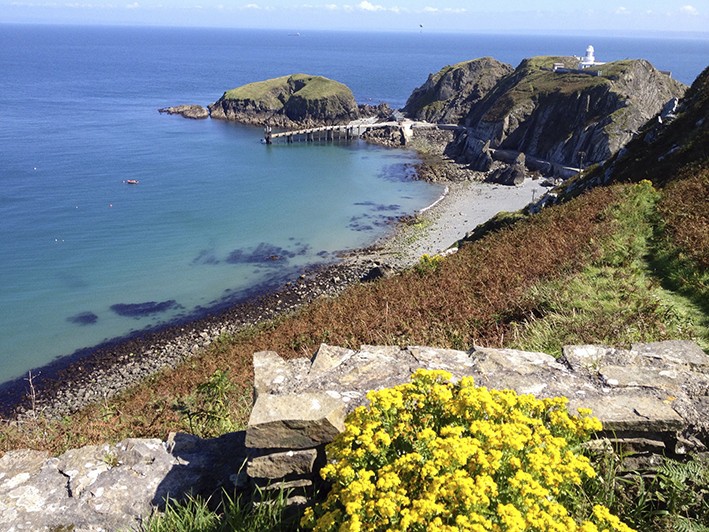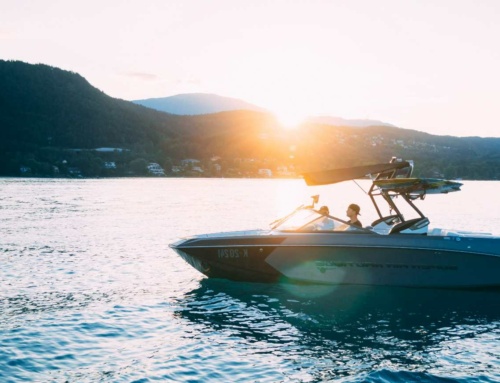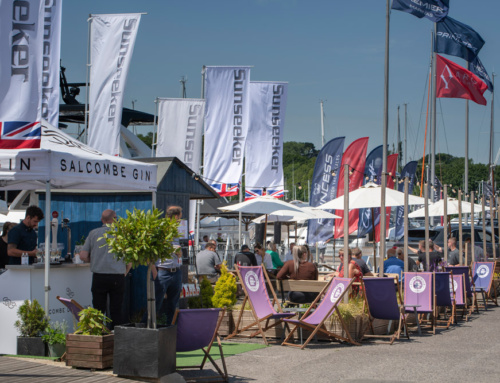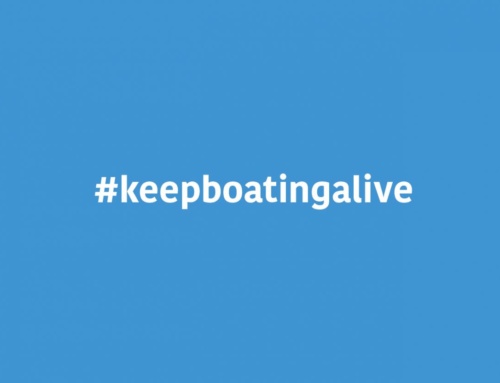Gary Workman recounts the tale of his latest group RIB adventure, this time from the North Devon port of Ilfracombe to experience the unique environment of the Isle of Lundy.
Set amidst the mighty Atlantic, Lundy was a past hideout for pirates and rogues, but today it’s recognised as a marine nature reserve of rare beauty. It is an unmissable destination for an adventure-seeking group such as ours, and after the success of the Bristol to Penarth run in June, the decision to visit Lundy on our next trip was an easy one.
This group just keeps on growing, and we now have over 2,500 members, with no sign of a let-up in this expansion. There is a wealth of knowledge and experience within the group, and the desire to share and enjoy it together is quite evident. All of us are on hand to help each other, and it does not matter whether you are just starting out ribbing or, like me, you have been boating for many years, as everyone is made to feel special and we all learn from each other. But before we ‘get underway’ in relating our passage out to the Isle, allow me to set the scene by telling you a little about this incredible location; particularly its natural wonders; you might say, ‘The gem in this island’s crown’… .
About the island
Lundy is the largest island in the Bristol Channel and lies 12 miles off the coast of Devon, about a third of the distance across the channel between Devon and South Wales. At the last official count (2007), Lundy had a resident population of 28 people, including a warden, ranger, island manager and farmer, as well as bar and housekeeping staff. Most live in and around the village in the south of the island.
Most visitors are day-trippers, although there are 23 holiday properties and a campsite for staying visitors, again mostly around the south of the island. In a 2005 opinion poll of Radio Times readers, Lundy was named Britain’s tenth greatest natural wonder. The entire island has been designated as a Site of Special Scientific Interest and it was England’s first statutory Marine Nature Reserve, and the first Marine Conservation Zone, because of its unique flora and fauna. It is managed by the Landmark Trust on behalf of the National Trust.
The island is 3 miles long by a little over 0.6 miles wide, with an area of 1,100 acres. The highest point on Lundy is Beacon Hill, 469 feet above sea level. A few yards off the north-eastern coast is Seal’s Rock, unsurprisingly named after the seals that rest on and inhabit the islet. Lundy is primarily composed of granite, with slate at the southern end, and the plateau soil is mainly loam, with some peat.
Flora and fauna
Lundy is a haven for a wide range of flora and fauna – often the main attraction for those who place the island at the top of their visiting wish list. There is one endemic plant species, the Lundy cabbage, a species of primitive brassica. By the 1980s the eastern side of the island had become overgrown with rhododendrons, which had spread from a few specimens planted in the garden of Millcombe House in Victorian times, but eradication of this non-native plant has been undertaken by volunteers over the past 15 years in an operation known on the island as ‘rhody-bashing’.
As an isolated island on major migration routes, Lundy has a rich bird life, including large numbers of black-legged kittiwake, razorbill, guillemot, herring gull, lesser black-backed gull, fulmar, shag, oystercatcher, skylark, meadow pipit, common blackbird, robin and linnet. There are also smaller populations of peregrine falcon and raven. In addition, Lundy has attracted many vagrant birds, in particular species from North America, and the island’s overall bird list totals 317 species.
The name Lundy is believed to come from the old Norse word for ‘puffin island’ (lundey), lundi being the Norse word for a puffin and ey an island. Sadly, though, the number of puffins on the island declined in the late 20th and early 21st centuries, with the 2005 breeding population estimated to be only two or three pairs, as a consequence of depredations by brown and black rats (which have now been eliminated) and possibly also as a result of commercial fishing for sand eels, the puffins’ principal prey. Since 2005, however, the breeding numbers have been slowly increasing once again.
Lundy is also home to an unusual range of mammals, almost all introduced, including a distinct breed of wild pony, the Lundy pony. Until recently, Lundy and the Shiant Isles in the Hebrides were the only two places in the UK where the black rat could be found regularly. In the rest of the United Kingdom they have largely been replaced by brown rats except for occasional sightings in port towns and the Thames Estuary. They have since been eradicated on the island in order to protect the nesting seabirds. Other species that have made the island their home include the grey seal, sika deer, pygmy shrew and feral goats. In mid-2006, the rabbit population was devastated by myxomatosis, leaving only 60 pairs from the previous 15–20,000 individuals.
The trip begins
After checking the tide table for Ilfracombe, Lundy and surrounding areas, early October looked favourable for our adventure, and we contacted Lundy Island and informed them of our plans, which were met with warmth and enthusiasm. We had decided to spend our night on Lundy under canvas, so the island campsite was booked for the 23 members of our party and permission gained from the Landing Office to make everything official.
The day of the trip arrived. As we approached Ilfracombe in readiness for our departure, messages were sent to the forum on Facebook so that our trip could be
followed throughout. At the top of the tide we launched our RIBs, and once clear of Ilfracombe made our way to the open sea. There was a little fog around, but the sea state was flat calm and the sun soon burnt the fog away.
We powered on at 23 knots and before too long caught a glimpse of land in the distance. For many this was their first sight of this fabled isle, and although the members of the group were well versed in its history, geography and ecology, and had seen pictures of this wild and isolated place with its extraordinary flora and fauna, senses were stirred as we realised just how close we were getting to our target.
Heading towards the north end of the island, keeping close inward, we were met with seals and their pups, all clearly intrigued to discover who these visitors were. We carried on our passage along the island, quietly absorbing its breathtaking and savage beauty, until we approached the island’s landing bay, where we dropped
anchor for the night. The island could only be approached by tender, so once anchors had been deployed, we ventured across three at a time.
With everybody safely gathered on land, we then faced a 148-metre climb to the booking office and a long-awaited drink at the tavern. Once camp was pitched, some of us decided to take a look around the island and grasped the opportunity to
take photos of some of the wildlife and scenery – the first of many that will provide lifelong memories of our Lundy adventure. A few diehards decided they wanted to descend back down the coastal path to go wakeboarding, before heading back to meet us at the tavern for our evening meal. One member decided that she would swim ashore whilst making anchor, but on discovering that the dark object swimming around her RIB was a basking shark, she was quick to see the sudden attraction of the tender and plumped for the latter option.
The meal at the tavern was excellent and the service quick and extremely friendly. We sat round mulling over the events of the day, sharing stories, photographs and reflections and generally enjoying each other’s company.
After a night under canvas, with no mishaps, it was back to the tavern for full English breakfasts all round before eventually saying our goodbyes and thanking the helpful and friendly staff for their attention to our every need, and also for sharing their local knowledge, all of which was hugely appreciated.
Gear stowed, we returned in threes to our RIBs, and once aboard took a last look at this extraordinary island and the wonders it provides before setting off on our way back to Ilfracombe. As we began our journey, a lone kayaker who had injured his shoulder asked if we could take him back to Ilfracombe, which we were more than pleased to do. Our journey back was longer as we were restricted to some 8 to 10 knots in the far rougher conditions, but this only added to the interest and opened the eyes of some of our members to what this water can be like for the unsuspecting boater.
Safely back at Ilfracombe, the very grateful Kayaker rejoined his friends and we said our goodbyes to each other, sad that the adventure was over but with spirits high, having not only shared a unique RIB experience but also having had the opportunity to take in one of England’s little known treasures, and to meet some exceptionally warm, helpful and interesting people who made us all so very welcome. This to me is what boating and ribbing are all about – adventure, relaxation, shared experiences, challenge and reward, all in the company of fellow boaters who have become firm friends.
We may get the opportunity to do another trip before our next big RIB adventure in
June 2016 when this time RIBs from around Europe will be joining us.
Our thanks to Kevin Green in the lead boat, Devon Car Parks and the Ilfracombe harbour master for all their help over the weekend. Special thanks also go to the residents of Lundy Island and the tavern for making us so welcome and for giving us the opportunity to spend the weekend on their unique island.
Safe and happy ribbing to you all until the next time.
Gary Workman
A Turbulent History – Smugglers & Lost Fortunes
Lundy has evidence of visitation or occupation from the Neolithic period onward, with Mesolithic flintwork, Bronze Age burial mounds, four inscribed gravestones from the early medieval period and an early medieval monastery.
The history of Lundy is a long and turbulent one. The island was granted to the Knights Templar by Henry II in 1160. The Templars were a major international maritime force at the time, however it is unclear whether they ever took possession of the island. Ownership was disputed by the Marisco family, who may have already been on the island. But the Mariscos were fined, and the island was cut off from necessary supplies.
In 1235, William de Marisco was implicated in the murder of Henry Clement, a messenger of Henry III. Three years later an attempt was made to kill Henry III by a man who later confessed to being an agent of the Marisco family. William de Marisco fled to Lundy where he lived as a virtual king. He built a stronghold in the area now known as Bulls’ Paradise. In 1242, Henry III sent troops to the island. They scaled the island’s cliff and captured William de Marisco and 16 of his subjects. Henry III built the castle (sometimes referred to as Marisco Castle) in an attempt to establish the rule of law on the island and its surrounding waters.
Over the next few centuries, the island was hard to govern. Trouble ensued as both English and foreign pirates and privateers – including other members of the Marisco family – took control of the island for short periods. Ships were forced to navigate close to Lundy because of the dangerous shingle banks in the fast-flowing River Severn and Bristol Channel. This made the island a profitable location from which to prey on passing Bristol-bound merchant ships bringing back valuable goods from overseas.
The late 18th and early 19th centuries were years of lawlessness on Lundy, particularly during the ownership of Thomas Benson (1708–1772), a member of parliament for Barnstaple and Sheriff of Devon, who notoriously used the island for housing convicts whom he was supposed to be deporting.
Sir Aubrey Vere Hunt of Curraghchase purchased the island in 1802 for £5,270. Sir Vere Hunt installed on the island a small, self-contained Irish colony with its own constitution and divorce laws, coinage and stamps. He failed in his attempt to sell the island to the British government as a base for troops, and his son, Sir Aubrey Thomas de Vere, also had great difficulty in securing any profit from the property.
William Hudson Heaven purchased Lundy in 1834, as a summer retreat and for the shooting, at a cost of 9,400 guineas (£9,870). He claimed it to be a ‘free island’, and successfully resisted the jurisdiction of the mainland magistrates. Lundy was in consequence sometimes referred to as ‘the kingdom of Heaven’. It belongs, in fact, to the county of Devon. Many of the buildings on the island today, including St Helena’s Church, designed by the architect John Norton, and Millcombe House (originally known simply as the Villa), date from the Heaven period.
William Heaven was succeeded by his son, the Reverend Hudson Grosset Heaven, who, thanks to a legacy from Sarah Langworthy (née Heaven), was able to fulfil his life’s ambition of building a stone church on the island. St Helena’s was completed in 1896, and stands today as a lasting memorial to the Heaven period.
With the outbreak of the First World War, matters deteriorated seriously, and in 1918 the family sold Lundy to Augustus Langham Christie. In 1924, the Christie family sold the island to Martin Coles Harman, who proclaimed himself a king. Harman’s son, John Pennington Harman, was awarded a posthumous Victoria Cross during the Battle of Kohima, India in 1944. There is a memorial to him at the VC Quarry on Lundy.
Following the death of Harman’s son Albion in 1968, Lundy was put up for sale the following year. Jack Hayward, a British millionaire, purchased the island for £150,000 and gave it to the National Trust, who leased it to the Landmark Trust. Today the island has become a popular destination among boaters interested in discovering the raw beauty of its rich and varied flora and fauna as well as its stunning location, and is visited by over 20,000 day-trippers a year.
Marine Life – Wild & Rare
1971, a proposal was made by the Lundy Field Society to establish a marine reserve. Provision for the establishment of statutory Marine Nature Reserves was included in the Wildlife and Countryside Act 1981, and on 21st November 1986 the Secretary of State for the Environment announced the designation of a statutory reserve at Lundy.
There is an outstanding variety of marine habitats and wildlife and a large number of rare and unusual species in the waters around Lundy, including some species of seaweed, branching sponges, sea fans and cup corals. Creatures such as basking sharks, large numbers of grey Atlantic seals, common dolphin, and all manner of sea birds including puffins, shearwater, gannets and guillemots, can be seen in around the islands’ rugged shores. For those who dive or snorkel, the deep coves along the isle’s more protected east face, possess the most beautiful and abundant kelp forests.
In 2003, the first statutory No Take Zone (NTZ) for marine nature conservation in the UK was set up in the waters to the east of Lundy Island. In 2008, this was declared as having been successful in several ways, including the increasing size and number of lobsters within the reserve, and potential benefits for other marine wildlife. However, the No Take Zone has received a mixed reaction from local fishermen.
http://www.landmarktrust.org.uk/lundyisland/












